This foolproof recipe for Prime Rib is the only one you need! Learn how to cook a prime rib to perfection so that you can impress your holiday guests.
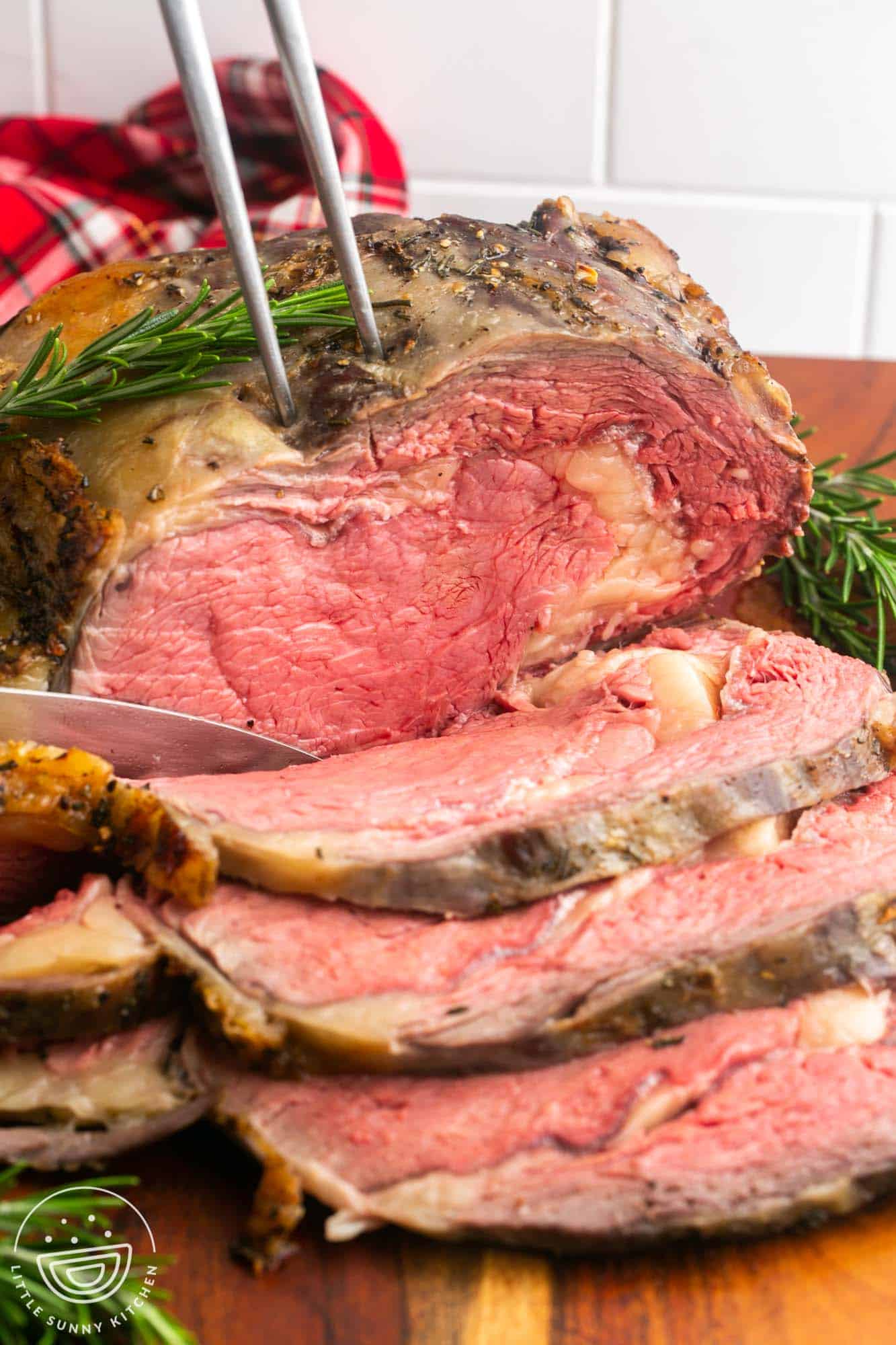
A perfectly roasted prime rib roast can be the gorgeous centerpiece for your Christmas dinner, New Year’s Eve, or other special occasion dinner.
Try serving it with twice baked potatoes and roasted broccolini for a restaurant-worthy feast!
This delectable cut of meat is expensive, so it can be stressful to cook, especially if you’ve never made prime rib before. Don’t worry! I’m here to show you the best way to cook a prime rib using the reverse sear method, and it’s nearly impossible to mess it up.
You might also enjoy making a Beef Tenderloin Roast. Either one is perfect for a special day.
What is Prime Rib?
Prime Rib might just be the most delicious beef roast available!

Specifically, this tender and delectable roast is cut from the seven ribs of a cow that are immediately before the loin. This is called the beef rib primal cut. Any good butcher will understand what you’re looking for if you ask them for a Prime Rib.
Chuck End or Loin End – There are two different cuts of prime rib. The chuck end will be more flavorful, with more of the spinalis muscle attached. The loin end is leaner, with less fat and less fat marbling.
Depending on where you live, you might find other options at your butcher. In the U.S, you can order a prime rib with the bones removed and then tied back on. I don’t find this to be necessary, but you can try it out if you like.
For a beautiful presentation, you can ask your butcher to “french” your rib roast, and they will remove any excess meat and fat around the bones to expose them.
The USDA gives beef different grades, with “prime” being the top tier. Prime rib isn’t necessarily prime grade, even though it has that word in the title. When shopping for a rib of beef roast, look for one with the most amount of marbling.
Prime rib comes in both bone-in and boneless varieties. I prefer to cook this beef roast with the bones. They add insulation to the meat, keeping it tender as it cooks.
This cut is also called a standing rib roast because when the bones are included, the bones stand up over the meat, and when cooked, those bones are under the roast, holding it up.
Why You’ll Love This Recipe
- All The Tips and Tricks – A standing rib roast can be quite expensive, so I know that it’s important not to mess it up! I’m giving you a simple recipe that’s easy to execute, and sharing tips along the way.
- Simple Cooking Method – I love the “reverse sear” cooking method when it comes to roasting prime rib. It’s easier than the traditional roasting method and results in evenly cooked meat.
Ingredients For the best prime rib
Here’s what you need to make this foolproof prime rib recipe
Complete list of ingredients and amounts can be found in the recipe card below.
- Prime Rib: This recipe will work for any size standing rib roast between 3-12 pounds. The one I’m cooking here is 6 pounds/3 bones and serves 6. You should plan around 1 pound of bone-in prime rib per person or 2 servings per bone.
- Salt and Pepper: Use kosher salt and ground black pepper to season the meat.
- Prime Rib Rub: A mixture of olive oil (or melted butter), freshly minced garlic, and chopped fresh herbs like rosemary or thyme adds just the right amount of flavor to prime rib.
How to Prepare a Prime Rib Roast Before Cooking
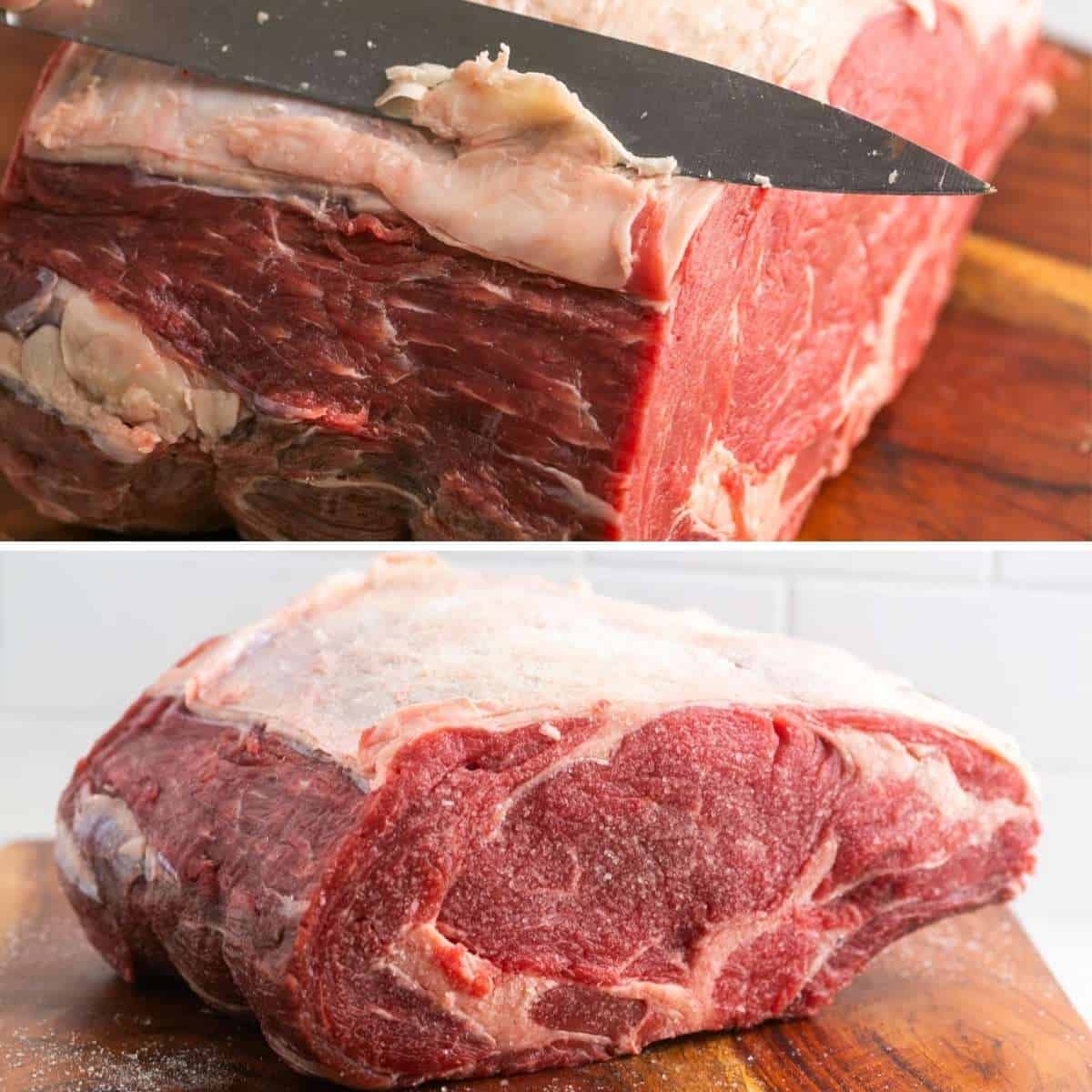
- Trim: Using a boning sharp knife, trim any excess fat, leaving about ¼ inch of fat around the roast. Do not trim it all! – it’s important to do this when the meat is cold, it’s so difficult to trim the fat when it’s at room temp as it becomes tender.
- Air Dry: This step is technically optional, but I highly recommend it! Use paper towels to dry the roast, then generously season with kosher salt on all sides (keep the black pepper for later). Place the prime rib on a wire rack and place it in the fridge, uncovered, for 1-4 days before cooking.
Tip!
Air drying makes the meat more flavorful, but if you aren’t going to air dry the prime rib, be sure to trim, dry and season it before cooking.
How To Cook Prime Rib
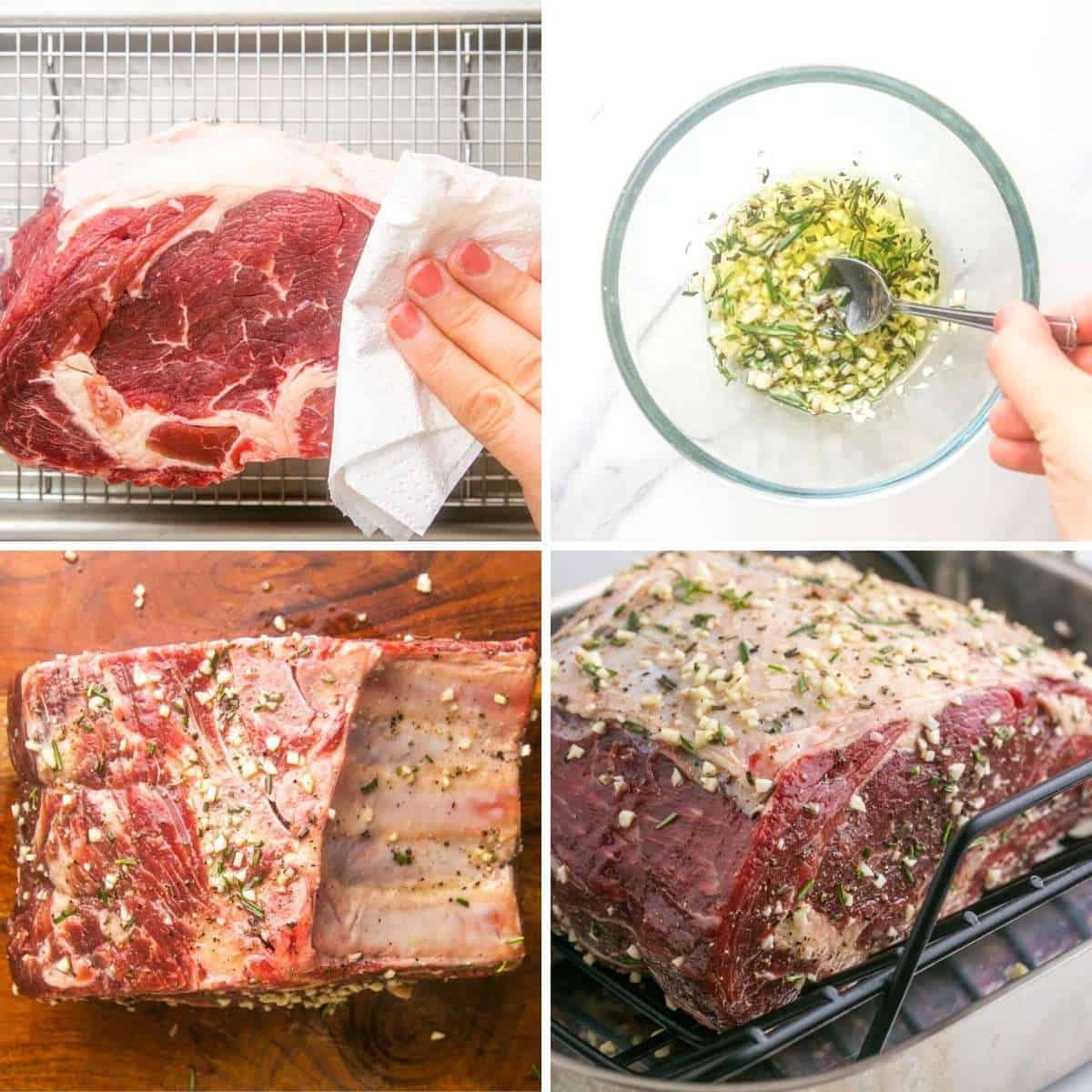
- Get Ready to Roast: Preheat the oven to 210°F/100°C, and add a rack to your roasting pan. I’m using this Roaster with a rack that I also use for roasting turkey, and even vegetables like this Stuffed Acorn Squash recipe. However, you can also use a cast iron pan if that’s what you have, just make sure that you place the roast bone side down so the bones work as a rack. You can also use a sheet pan fitted with a wire rack.
- Season: If you’ve already salted the meat, finish seasoning by sprinkling with ground black pepper from all sides. Otherwise, season now with salt and pepper.
- Add the Rub: After you’ve dried and seasoned the prime rib, make the rub by mixing together olive oil, minced fresh garlic, and chopped rosemary. Rub the mixture all over the roast using your hands.
- Roast: Place the roast on the roasting rack, fat cap side up, and cook in the oven uncovered until the internal temperature reaches 125-130°F/51-54°C for medium rare. This will take between 2 and a half to 4 hours, depending on the size of the roast. Start checking the internal temperature at 2 hours using a meat thermometer, to make sure that you don’t end up overcooking the roast.
- Rest: Remove the meat from the oven and place it on a cutting board. Tent loosely with foil and allow it to rest for 1 hour, this allows the meat to relax and redistribute the juices, which creates a more tender, juicier roast.
- Sear: Preheat your oven to the highest possible temperature (mine goes to 500°F/250°C). Place the prime rib back on the roasting rack in the pan and “sear” in the very hot oven for 8-10 minutes to create a brown, crisp crust on the outside.

- Serve: Once the prime rib has seared, it’s ready to serve. There’s no need to let it rest at this point.
Is it better to reverse sear a prime rib?
Yes, it is!
Traditionally, standing rib roast is blasted in a very hot oven to cook the exterior and then cooked gently until it reaches 125°F or medium rare. There is a problem with this method because you end up with an overcooked ring of gray meat on the outside by the time the center is cooked properly.
So instead we’re doing the opposite, and cooking prime rib at a lower heat first so it cooks gently and evenly, then finishing with a hot oven sear for a nice brown crisp exterior. It’s a simple solution to the problem!
The other great part about the reverse-sear method is that the roast is ready to serve when it comes out of the oven for the last time, so it’s hot and delicious.
Recipe Tips
- For Even Cooking, you need to let the roast sit out at room temperature for 2-3 hours before cooking it. If you roast prime rib directly from the fridge, the ends will overcook and the center will be undercooked.
- Don’t Trim Too Much. While you should remove any excess fat from your roast, leave some of it on. That layer of fat will help keep the meat juicy and it will render beautifully.
- Serve Prime Rib with Horseradish Sauce. Some may enjoy just prepared horseradish with their meat, but I prefer to make this extra flavorful creamy sauce. Everyone loves this, so feel free to make extra! It’s great to dip french fries or onion rings in too.
- Plan Ahead. It really makes a big difference if you can dry the roast in the fridge for a few days. Do that part up to 4 days before you’re going to serve prime rib for dinner.
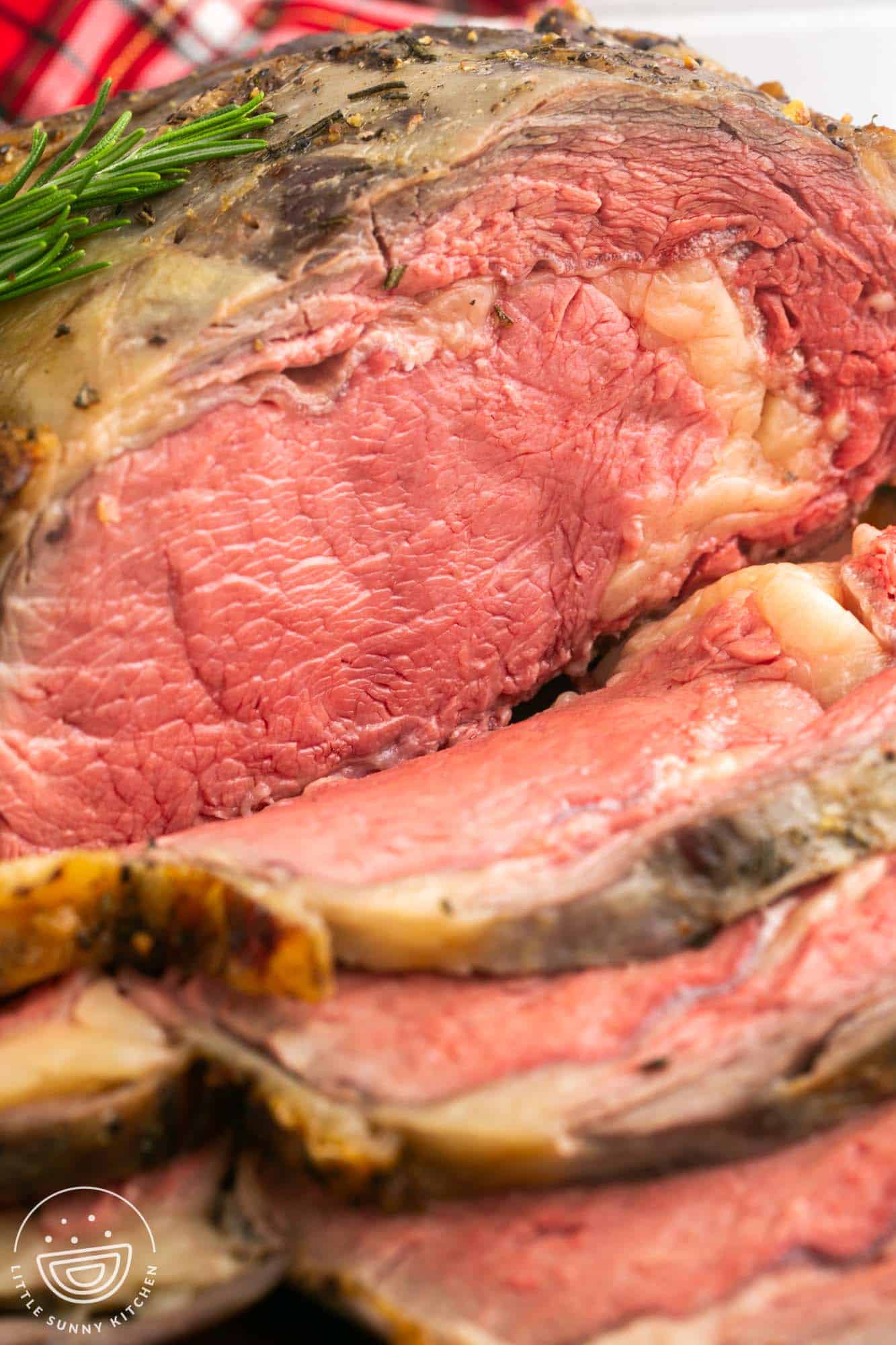
What Temperature Should You Cook Prime Rib To?
For medium-rare prime rib, you should roast the meat until it reaches an internal temperature of 125-130°F/51-54°C.
Medium-rare is generally how prime rib should be served. It’s the way most people prefer to enjoy this cut of meat.
But, if you prefer the roast cooked to a different temperature, you can adjust this recipe and cook your standing rib roast until it’s the way you like it.
- Keep in mind that the temperature of the meat will rise about 10°F while it’s resting.
- The final prime rib temperature for rare meat is 120-125°F. Medium is 130°-135°F, and well done is over 140°F.
Storing Tips
Store leftover beef roast in the refrigerator in an airtight container for up to 5 days.
I typically slice the leftovers before putting them away so that I can make prime rib sandwiches the next day.
You can also use the leftover rib of beef roast to make a delicious prime rib pasta dish.
What To Serve With Prime Rib
If you’re serving a high-quality beef roast you should be prepared to serve equally amazing side dishes with it! Here are my recommendations for the best side dishes for prime rib.
- A Rich Potato Side: Boursin Mashed Potatoes, Twice Baked Potatoes, or Instant Pot Scalloped Potatoes.
- A Fancy Vegetable Dish: Bacon Wrapped Asparagus, Roasted Broccolini, or Sauteed Mushrooms and Onions.
- As an Appetizer: Try Sausage Stuffed Mushrooms or a festive Christmas Tree Cheese Ball.
- Salad or Soup as the First Course: Iceberg Wedge Salad with blue cheese, Shaved Brussels Sprout Salad, Roasted Butternut Squash Soup, or Cream of Broccoli Soup.
- A Decadent Dessert: Pecan Pie Cheesecake, Oreo Cheesecake, Classic Red Velvet Cake, or my Easy Tiramisu Recipe.
Frequently Asked Questions
I prefer not to, but it is an option that you could consider. Some people like to cut away the bones and then use them to create a bone rack on the bottom of the pan.
This method can make it easier to slice and serve the prime rib after it’s cooked, but it is much more prep work.
Basically, yes. A standing rib roast is the style of the cut. A prime rib roast is a standing rib roast cut specifically from the “primal” section, which is the 7 ribs immediately before the loin.
You should plan on at least 1 pound of bone-in prime rib per person or 2 servings per bone.
You’ll be so happy that you decided to reverse-sear your prime rib! Save this recipe for your next special occasion or holiday dinner. Be sure to Pin it too!
Did you make this? Be sure to leave a review below and tag me on Facebook, Instagram, or Pinterest!
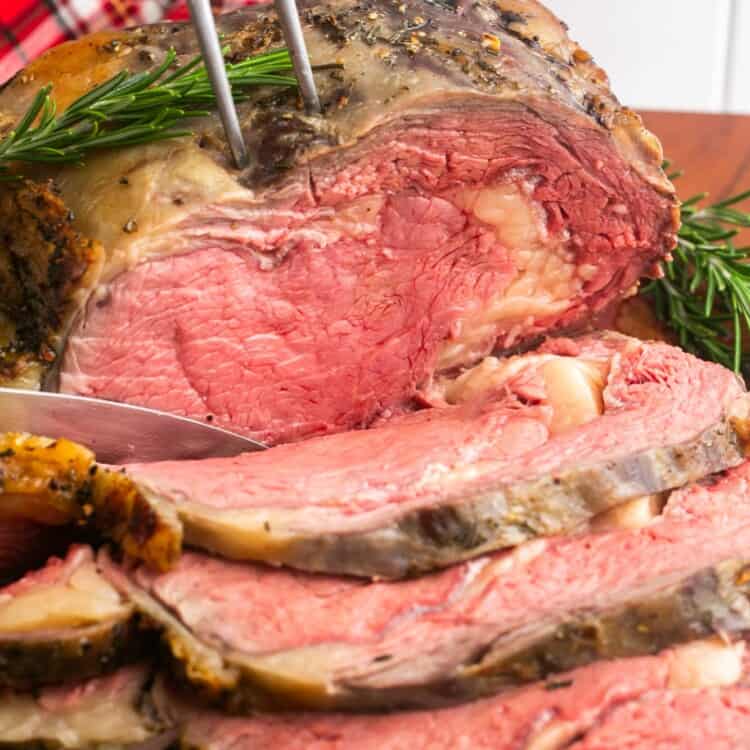
Prime Rib
Equipment
- Roasting pan with rack
- Kitchen thermometer
Ingredients
- 1 prime rib 3-12 lb (mine was 6lb)
- Kosher salt
- Ground black pepper
For the rub
- 2 tablespoons olive oil or melted butter
- 1 tablespoon chopped fresh rosemary
- 3 cloves garlic minced NOT pressed
Instructions
1 – 4 days before roasting (optional):
- Using a boning knife, trim any excess fat, leaving about ¼ inch of fat around the roast. Do not trim it all! – it’s important to do this when the meat is cold, it’s so difficult to trim the fat when it’s at room temp as it becomes tender
- With paper towels, pat the roast dry then generously season with kosher salt from all sides. Place on a wire rack, and keep in the fridge uncovered to air dry for 1-4 days.
On the day of roasting:
- Remove the roast from the fridge 2-3 hours prior to roasting so it comes to room temp. This is a very important step, don’t skip it!
- Preheat the oven to 210°F/100°C.
- Pat the roast dry with paper towels, if it wasn’t salted before then generously season it with kosher salt, and sprinkle with ground black pepper from all sides.
- Make the rub. In a small bowl combine the olive oil with rosemary and garlic then rub on the roast, and spread it well with your hands.
- Place the roast on a roasting pan with a rack, fat cap side UP and place in the oven until the internal temperature registers 125-130°F/51-54°C for medium rare. This will take around 2 and half to 4 and half hours depending on the size of the roast. Start checking the internal temperature at 2 hours using a meat thermometer, to make sure that you don't end up overcooking the roast.
- Remove from the oven onto a cutting board, cover loosely with foil and allow to rest for one hour.
- Preheat the oven to the highest possible temp (mine goes up to 500°F/250°C), remove foil and place the roast on the roaster again and “sear” in the oven for 8-10 minutes. This will form a nice crust that is brown and crisp. Remove from the oven, no need to let it rest, carve and serve with horseradish sauce.
Notes:
- The time it takes to cook this prime rib recipe will depend on the size of your roast. Plan on cooking for about 30 minutes per pound, but use an instant-read thermometer for accuracy.
- For medium-rare prime rib, you should roast the meat until it reaches an internal temperature of 125-130°F/51-54°C.
- The final prime rib temperature for rare meat is 120-125°F. Medium is 130° – 135°F, and well done is over 140°F.
- Keep in mind that the meat will rise in temperature about 10°F while it’s resting.
- For Even Cooking, you need to let the roast sit out at room temperature for at least an hour before cooking it. If you roast prime rib directly from the fridge, the ends will overcook and the center will be undercooked.
- When Buying, ask for a prime rib cut from the chuck end rather than the loin end.
- Don’t Trim Too Much. While you should remove any excess fat from your roast, leave some of it on. That layer of fat will help keep the meat juicy.
- Slice into ½ to ¾ inch slices for serving.
- Serve Prime Rib with Horseradish Sauce. Some may enjoy just prepared horseradish with their prime rib, but I prefer to make this extra flavorful creamy sauce.
- Plan Ahead. It really makes a big difference if you can dry the roast in the fridge for a few days. Do that part up to 4 days before you’re going to serve prime rib for dinner.
- To Store: Store leftover prime rib in the refrigerator in an airtight container for up to 5 days.
Nutrition Information
This website provides approximate nutrition information for convenience and as a courtesy only. Nutrition data is gathered primarily from the USDA Food Composition Database, whenever available, or otherwise other online calculators.
© Little Sunny Kitchen
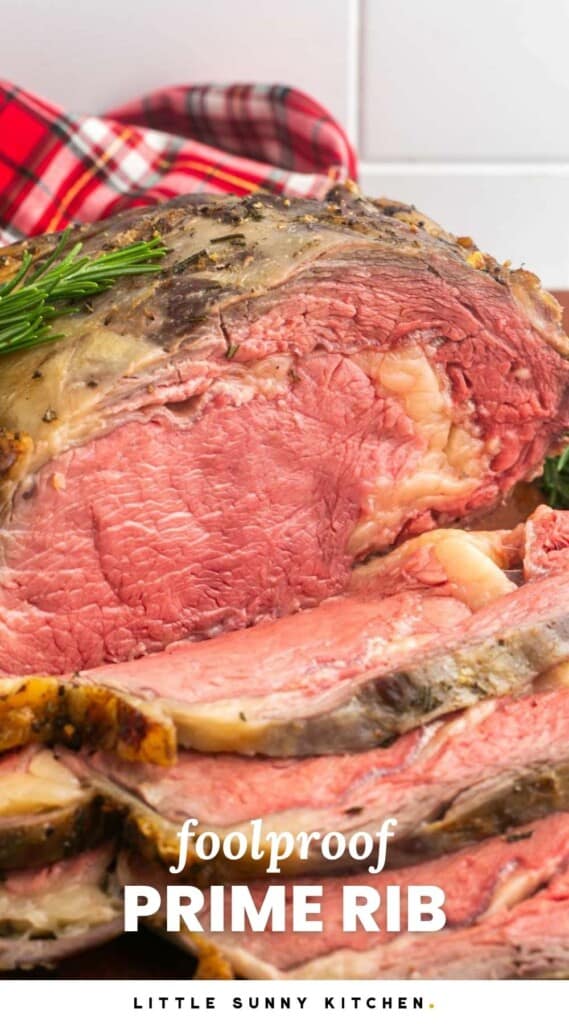
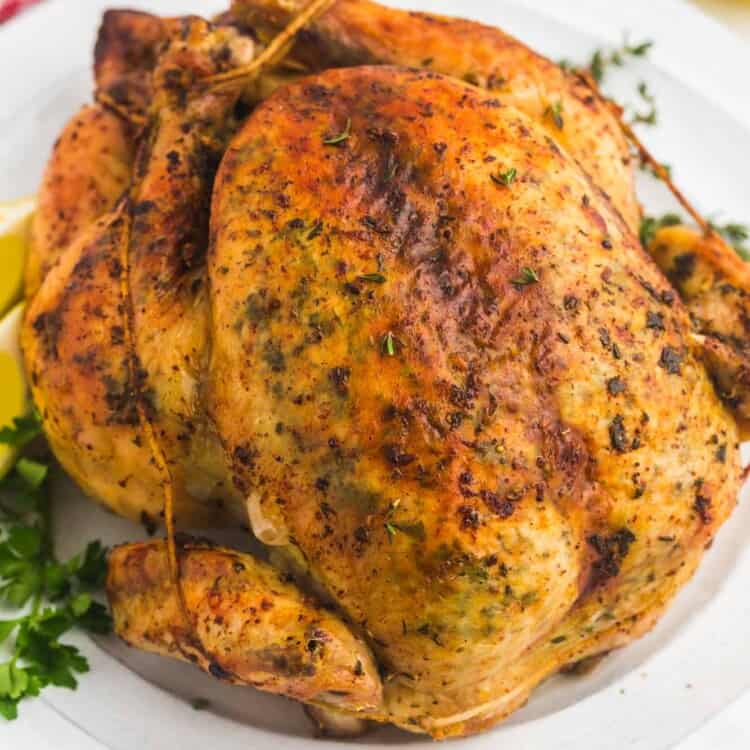
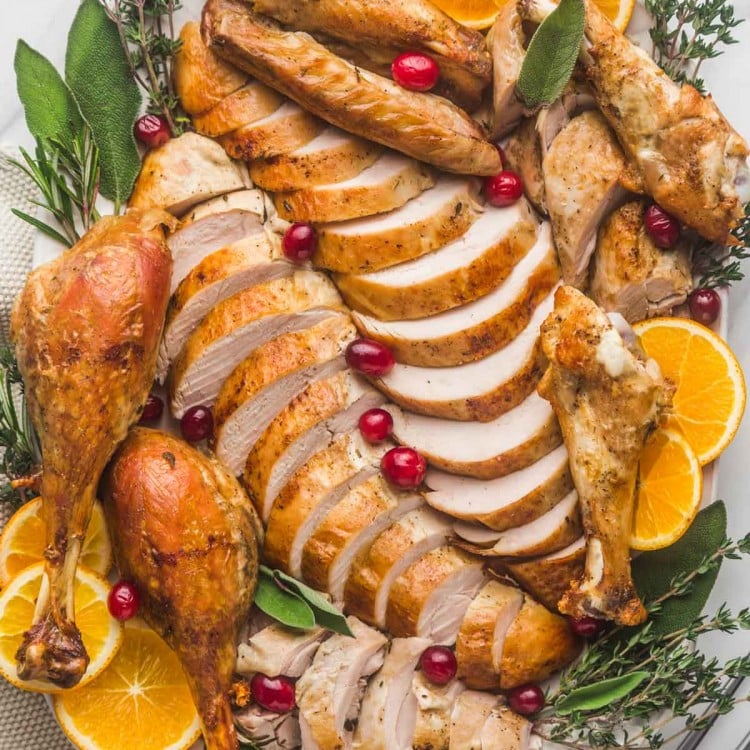
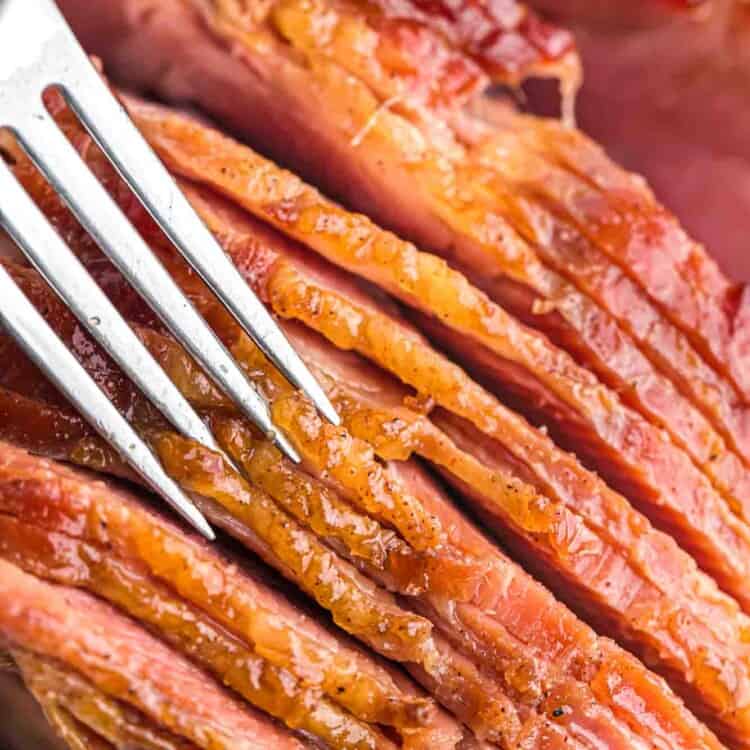
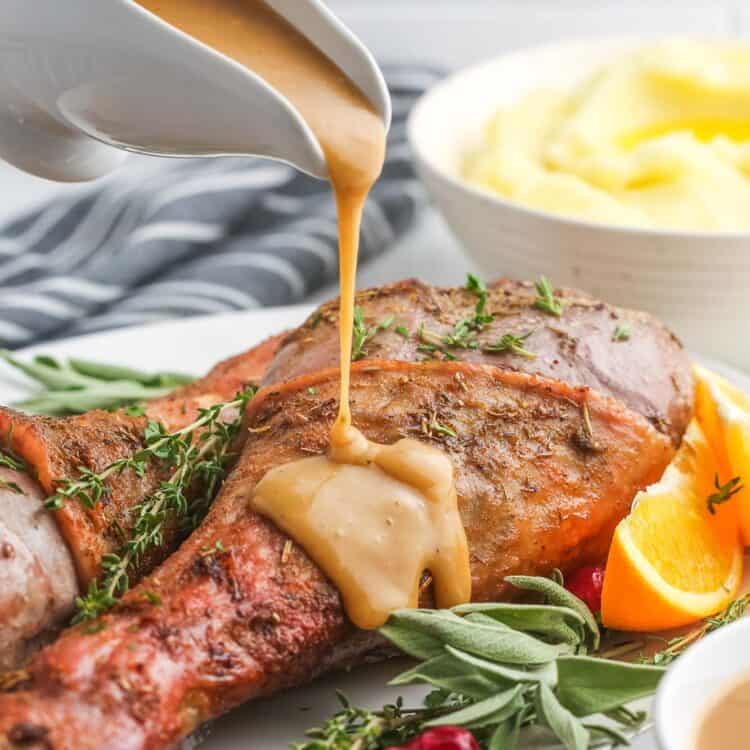

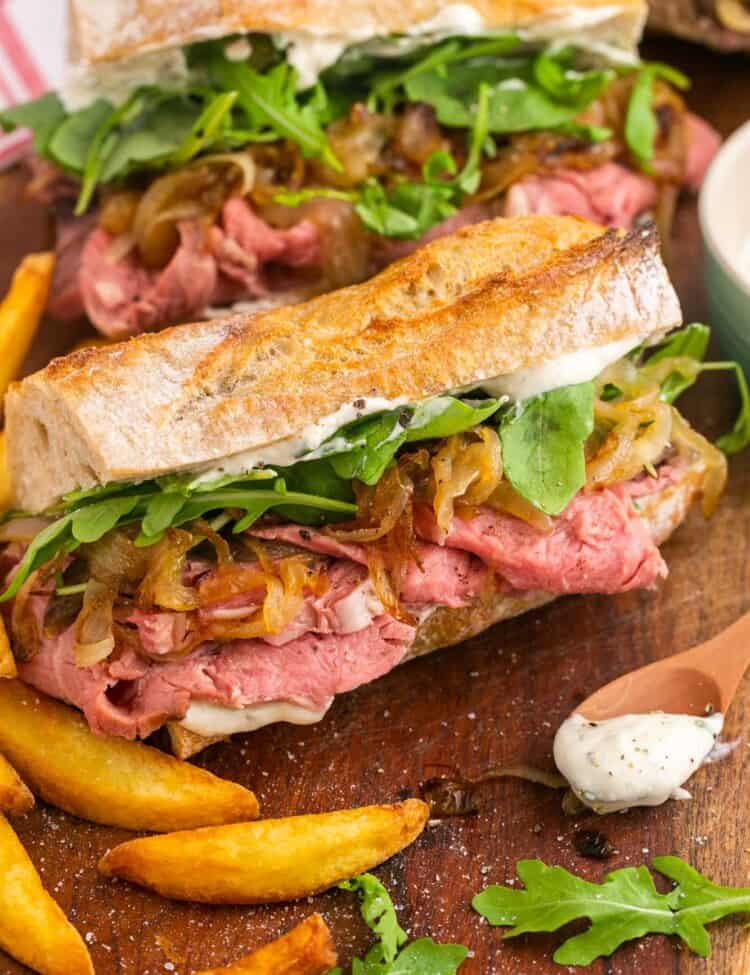


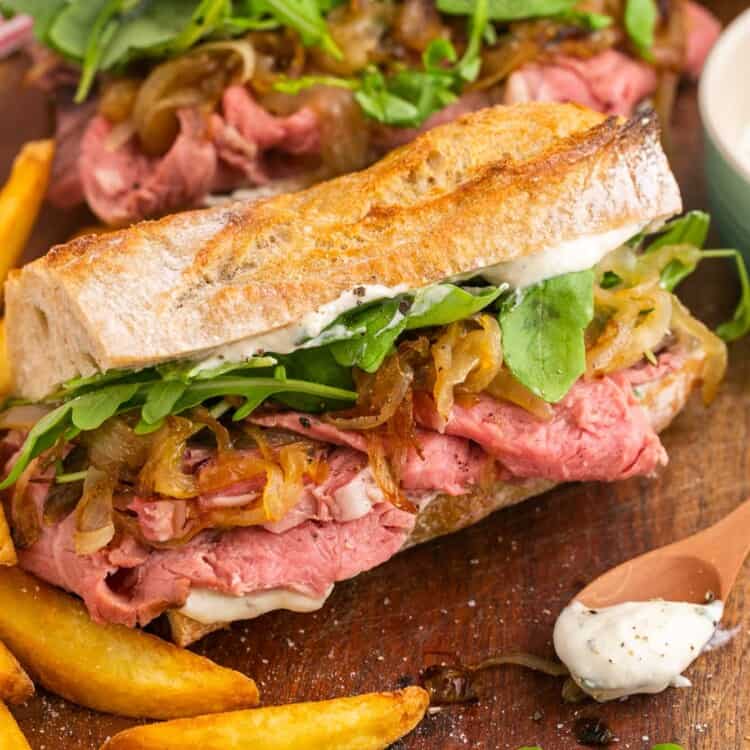
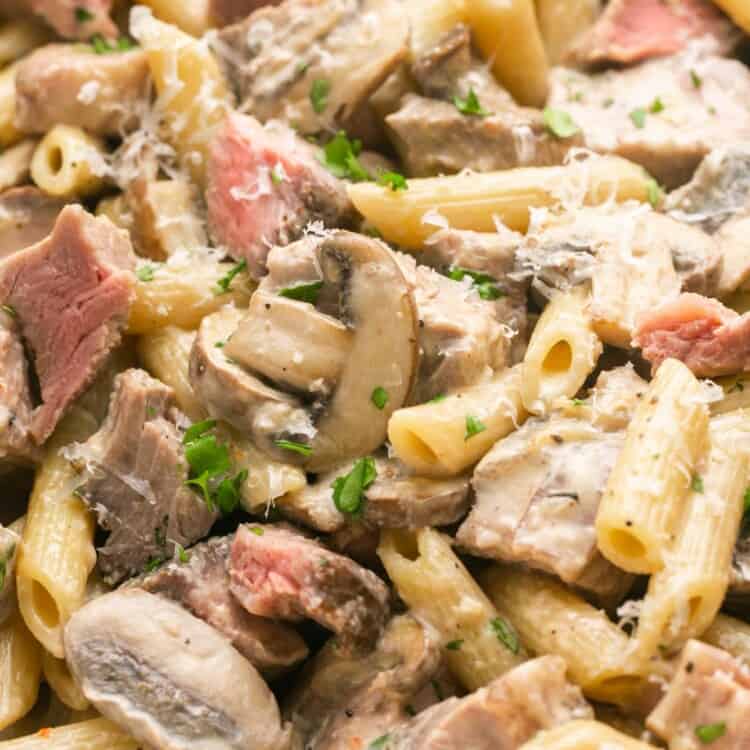
Melissa says
I love this reverse method – cooked perfectly to medium rare, juicy, tender, and delicious! 10/10 making it again soon
Little Sunny Kitchen says
Thank you for your kind review, Melissa! I’m so glad you enjoyed this recipe!
Allyson Zea says
I cooked this steak for dinner the other night and it turned out great! It was amazingly tender and juicy. Will definitely be making this recipe again!
Little Sunny Kitchen says
Thank you for the great review, Allyson! So happy to hear you enjoyed this recipe!
Sara Welch says
Enjoyed this for dinner last night and it does not disappoint! Turned out perfectly tender, juicy and packed with flavor!
Little Sunny Kitchen says
So glad you enjoyed this recipe, Sara! Thank you for leaving such a kind review!